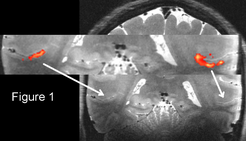Ultra-high resolution anatomical brain images
Using 7 T scanning techniques we are able to obtain high quality submillimeter resolution images of sections of the brain in less than 10 min of scanning time. The images contain a wealth of detail regarding cortical and deep brain substructures that have been completely inaccessible in living human brain at lower field strengths. The challenge is to match anatomically defined cortical regions with their specific role in various brain tasks. Previous work, with much less detailed MRI cortical anatomical information, was able to provide only a vague association, on the scale of several millimeters, between brain region and brain task.

At 7 T we can rapidly localize brain function, for a wide range of tasks, to a resolution of 1 mm and even below, using appropriate developments of the widely-used very fast EPI scanning techniques brought in at high field by Professor Turner. These can give a temporal resolution of about one second, limited only by the relatively slow response of the brain's blood supply to changes in neuronal activity. With a wide range of high-resolution anatomical techniques we will then identify the structural substrate of functionally specific brain activity, wherever possible, on a scale of half a millimeter and below. An example of visible layer structure is shown in Figure 1 where the motion sensitive area V5 was imaged. Additionally the activation pattern is overlaid onto the anatomical image. The activated area nicely fits the visible layer structure.
Internal Collaborators include:
- PD Dr. Stefan Geyer
- Dipl.-Inf (FH) Marcel Weiss
- Dr. Andreas Schäfer
External Collaborators include:
- Dr David L. Thomas - University College London School of Life and Medical Sciences, London, UK
- Dr David Carmichael - University College London School of Life and Medical Sciences, London, UK
- Dr David D. Feinberg – Advanced MRI Technologies, Sebastopol, USA
- PD Dr. Gabriele Lohmann, Max-Planck-Institut für biologische Kybernetik
